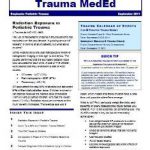There will not be a scheduled post today or tomorrow. We are undergoing an American College of Surgeons reverification visit for our adult and pediatric Level I trauma centers today. Things are a bit busy, but I’ll resume on Thursday!
Category Archives: General
Yes, Smoking is Bad!
Everybody knows that smoking is bad. But how often have you stopped by to see one of your trauma patients and have been told “they’re out smoking?” Well, it turns out it’s bad for their injuries as well.
A German group looked at the effects of smoking on healing of a “simple” tibial fracture. They looked at 103 patients who underwent treatment for an isolated tibial shaft fracture at a trauma center. Patients with more complicated problems like extension into a joint, open fracture (Gustilo III), or significant soft tissue injury were excluded.
Patients were divided into non-smokers and smokers (including previous smokers). A total of 85 patients were studied, and there were roughly half in each group. The nonsmoking group experienced no delayed or non-unions of their fractures. The smoking group reported 9 delayed unions and 9 non-unions in 46 patients! As expected, time off work and eventual functional outcome was worse as well.
Bottom line: The exact mechanism for impairment of fracture healing by smoking is unclear. It may be due to physiologic effects of inhaled tobacco components on blood flow, blood vessels, transforming growth factor levels or collagen formation. It could also be a secondary effect of socioeconomic variables, patient compliance, or a host of other factors. Regardless, it’s bad. Smoking should be forbidden while in hospital, and should be strongly discouraged after discharge.
Reference: Cigarette smoking influences the clinical and occupational outcome of patients with tibial shaft fractures. Injury 42:1435-1442, 2011.
Newsletter
I’ve been providing an educational newsletter based on this blog to trauma professionals in Minnesota and Western Wisconsin for several months. I’d like to take this opportunity to share it with the larger community of trauma pros and get your feedback about the content.
There is a tremendous amount of information in my archives, and some of the good stuff tends to get forgotten. So I’ve been adopting a theme for each month, and then consolidating and updating some of the information I’ve posted about it over the past several years.
Have a look at the September newsletter and let me know what you think. I’ll plan on posting an issue every month. As always, special requests for posts are always appreciated.
Click here (or the picture) to download the Trauma MedEd Newsletter.
IV Contrast
We use CT scanning in trauma care so much that we tend to take it (and its safety) for granted. I’ve written quite a bit about thoughtful use of radiographic studies to achieve a reasonable patient exposure to xrays. But another thing to think about is the use of IV contrast.
IV contrast is a hyperosmolar solution that contains some substance (usually an iodine compound) that is radiopaque to some degree. It has been shown to have a significant impact on short-term kidney function and in some cases can cause renal failure.
Here are some facts you need to know:
- Contrast nephrotoxicity is defined as a 25% increase in serum creatinine, usually within the first 3 days after administration
- There is usually normal urine output and minimal to no proteinuria
- In most cases, renal function returns to normal after 3-4 days
- Nephrotoxicity almost never occurs in people with normal baseline kidney function
- Large or repeated doses given within 72 hours greatly increase risk for toxicity
- Old age and pre-existing diabetic renal impairment also greatly increase risk
If you must give contrast to a patient who is at risk, make sure they are volume expanded (tough in trauma patients), or consider giving acetylcysteine or using isosmolar contrast (controversial, may still cause toxicity).
Bottom line: If you are considering contrast CT, try to get a history to see if the patient is at risk for nephrotoxicity. Also consider all of the studies that will be needed and try to consolidate your contrast dosing. For example, you can get CT chest/abdomen/pelvis and CT angio of the neck with one contrast bolus. Consider low dose contrast injection if the patient needs formal angiographic studies in the IR suite. Always think about the global needs of your patient and plan accordingly (and safely).
Related posts:
Reference: Contrast media and the kidney. British J Radiol 76:513-518, 2003.
Animal Strikes
This is a bad time of year in much of the United States for striking animals on the road. Car vs animal can be challenging, and motorcycle vs animal is frequently deadly. What can our patients do to protect themselves?
- Be especially vigilant when driving for the first few hours after sunset and just before sunrise. More animal activity occurs during these hours.
- If one animal is spotted, look out for others.
- Drive with high beams on as much as possible. In many animals, this will show reflections from their eyes. Some large animals, such as moose, don’t have glowing eyes.
- Always where a seat belt in case an impact does occur.
- If an animal is spotted, slow down quickly and blow the horn.
Most important! NEVER swerve or attempt to quickly change direction. This is one of the most common errors that results in serious injury or death. The driver swerves to avoid and begins to leave the roadway. They then over-correct in the opposite direction and begin a rollover. Always make gentle corrections, staying in the same lane.
For small animals, try to straddle them with the wheels. For larger ones, try to plan the impact so it is in front of the unoccupied front passenger seat. If occupied, plan the strike in the middle of the hood. The idea is to keep the car occupants safe, but to assist with natural selection and remove the animal from the gene pool.




